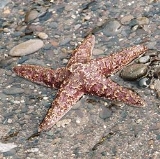
Eleutherozoa
Encyclopedia
Eleutherozoa is a subphylum
of echinoderm
s. They are mobile animals with the mouth directed towards the substrate. They usually have a madreporite
, tube feet
, and moveable spines of some sort, and some have Tiedemann's bodies on the ring canal. All living echinoderms except Crinoidea belong here.
The "Cryptosyringida" hypothesis posits that the "sea-star" morphology
is plesiomorphic for Eleutherozoa as a whole, and that starfish (Asteroidea) and brittle stars are not very closely related, the latter forming the clade
Cryptosyringida together with the Echinozoa
. The "Asterozoa" hypothesis on the other hand implies that the "sea-star" arms of starfish and brittle stars, as well as the rounded shape of Echinozoa, both evolved independently from an ancestor of unknown morphology, but that each "armed" and "rounded" lineages are strictly monophyletic. Too little is known of the basal
eleutherozoans and echinoderms to be able to firmly decide for or against any of these hypotheses at present.
The Asterozoa would have to be ranked as a superclass or treated as an unranked clade between the Cryptosyringida and the Eleutherozoa, depending on whether the "Asterozoa" or "Cryptosyringida" hypothesis turns eventually out to be correct.
Emerging research favours the following classification:
Subphylum
In life, a subphylum is a taxonomic rank intermediate between phylum and superclass. The rank of subdivision in plants and fungi is equivalent to subphylum.Not all phyla are divided into subphyla...
of echinoderm
Echinoderm
Echinoderms are a phylum of marine animals. Echinoderms are found at every ocean depth, from the intertidal zone to the abyssal zone....
s. They are mobile animals with the mouth directed towards the substrate. They usually have a madreporite
Madreporite
The madreporite is a lightcolored calcerous opening used to filter water into the water vascular system of echinoderms. It acts like a pressure-equalizing valve. It is visible as a small red or yellow button-like structure, looking like a small wart, on the aboral surface of the central disk of a...
, tube feet
Tube feet
Tube feet are the many small tubular projections found most famously on the oral face of a sea star's arms, but are characteristic of the water vascular system of the echinoderm phylum which also includes sea urchins, sand dollars and sea cucumbers and many other sea creatures.Tube feet function in...
, and moveable spines of some sort, and some have Tiedemann's bodies on the ring canal. All living echinoderms except Crinoidea belong here.
Systematics
There are 2 main competing hypotheses about the internal subdivision, both about equally well supported by both molecular and morphological data. They differ in their placement of the Ophiuroidea (brittle stars), and are named accordingly.The "Cryptosyringida" hypothesis posits that the "sea-star" morphology
Morphology (biology)
In biology, morphology is a branch of bioscience dealing with the study of the form and structure of organisms and their specific structural features....
is plesiomorphic for Eleutherozoa as a whole, and that starfish (Asteroidea) and brittle stars are not very closely related, the latter forming the clade
Clade
A clade is a group consisting of a species and all its descendants. In the terms of biological systematics, a clade is a single "branch" on the "tree of life". The idea that such a "natural group" of organisms should be grouped together and given a taxonomic name is central to biological...
Cryptosyringida together with the Echinozoa
Echinozoa
Echinozoa is a subphylum of free-living echinoderms in which the body is essentially globoid with meriodional symmetry. They lack arms, brachioles, or other appendages, and do not at any time exhibit pinnate structure....
. The "Asterozoa" hypothesis on the other hand implies that the "sea-star" arms of starfish and brittle stars, as well as the rounded shape of Echinozoa, both evolved independently from an ancestor of unknown morphology, but that each "armed" and "rounded" lineages are strictly monophyletic. Too little is known of the basal
Basal (phylogenetics)
In phylogenetics, a basal clade is the earliest clade to branch in a larger clade; it appears at the base of a cladogram.A basal group forms an outgroup to the rest of the clade, such as in the following example:...
eleutherozoans and echinoderms to be able to firmly decide for or against any of these hypotheses at present.
The Asterozoa would have to be ranked as a superclass or treated as an unranked clade between the Cryptosyringida and the Eleutherozoa, depending on whether the "Asterozoa" or "Cryptosyringida" hypothesis turns eventually out to be correct.
Emerging research favours the following classification:

